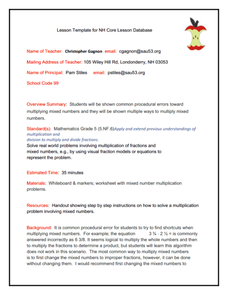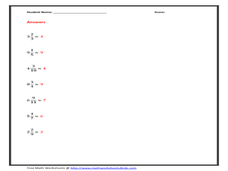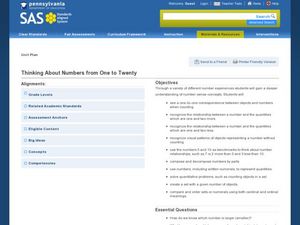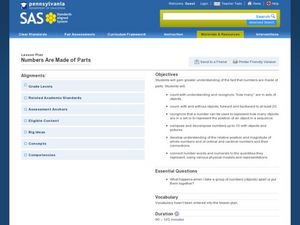EngageNY
Sampling Variability
Work it out — find the average time clients spend at a gym. Pupils use a table of random digits to collect a sample of times fitness buffs are working out. The scholars use their random sample to calculate an estimate of the mean of the...
Charleston School District
Scientific Notation Operations
How do you operate with numbers in scientific notation? The resource provides examples on how to divide and multiply with numbers written in scientific notation. The handout and video also cover the procedure for addition and subtraction...
Curated OER
Estimate and Compare Data
Seventh graders explore the values that are used in order to describe data that is collected or given. They compare data using the statistical analysis provided by finding the mean, median, and range.
EngageNY
Irrational Exponents—What are 2^√2 and 2^π?
Extend the concept of exponents to irrational numbers. In the fifth installment of a 35-part module, individuals use calculators and rational exponents to estimate the values of 2^(sqrt(2)) and 2^(pi). The final goal is to show that the...
Charleston School District
Evaluation of Roots
You mean the square root of five and five don't have the same value? Learners estimate the value of irrational roots. As they practice estimating the value, they increase their understanding of roots. The lesson is the fourth in a series...
Curated OER
Two-Digit Quotients
In this mathematics worksheet, 6th graders find the quotient for each problem. They estimate first and identifying which number they will use. Then, students divide the problem and multiply to check.
Curated OER
Multiplying Mixed Numbers
In this multiplying mixed numbers worksheet, students with a partner problem solve and calculate the answers to ten word problems and mathematical equations.
Curated OER
Whole Number Game Time
First graders play math games to develop a better understanding of whole numbers. They represent and use whole numbers up to 100. They estimate how many times they would have to roll two dice before they would get to 100 and record...
Curated OER
Multiply Whole Numbers and Decimals: Reteach
In this whole number and decimal multiplication worksheet, students review the three steps to multiply whole numbers and decimals. Students then find the products for the sixteen problems.
Curated OER
Rounding Numbers
In this rounding numbers worksheet, students, with a partner, problem solve and calculate the answers to eighteen mathematical exercises.
Curated OER
Show What You Know: Estimate: Enrichment
For this estimating sums worksheet, learners write a greater than or less than sign to solve the addition sentences. Students first use estimation to help them compare the numbers.
Curated OER
Estimate the Mixed Fractions
In this fraction estimation learning exercise, students estimate seven mixed fractions to the nearest whole number. There is an answer sheet included.
Curated OER
Estimate Fractions Worksheet
In this fraction estimation worksheet, students complete eight problems where they estimate the fractions to the nearest whole number. The fractions on the worksheet are mixed and improper.
Curated OER
Estimating Solutions
Finding approximate solutions to word problems allows users to assess the reasonableness of their answers. In a well-paced lesson, the class rounds numbers to estimate the solutions. They explain their thinking and determine if the...
Ohio Department of Education
Fraction Models - Grade Three
Explore fractions using different manipulatives and illustrations. Your class can create a variety of models of fractions and mixed numbers with drawings and manipulatives. They then work to compare fractions, mixed numbers, and whole...
Curated OER
Understanding 10: Backwards and Forwards
Help your young mathematicians completely master 10 by practicing one-to-one correspondence, number recognition, and recording numbers displayed. They make 10 with groups of two-different colored cubes and color in 10-frames to show how...
Curated OER
Earth Day Number Sense
Elementary schoolers count and order objects using numbers 1-300. They bring recyclable items from home. Young scholars group the items, skip count by 2's, 3's, and 5's, and arrange the items on a number line. Recyclable plastic bags are...
Noyce Foundation
Fractured Numbers
Don't use use a fraction of the resource — use it all! Scholars attempt a set of five problem-of-the-month challenges on fractions. Levels A and B focus on creating fractions and equivalent fractions, while Levels C, D, and E touch on...
Curated OER
Reasonable Estimates
Help pupils explore estimation. They will make estimates and discuss when you might use an estimate. Then they discuss if their estimates are reasonable.
Curated OER
Estimate, Solve, and Check
Young scholars estimate, solve, and check a series of addition and subtraction number and word problems. They write their estimates on a recording sheet, compute and write the answer in the next column, and check their answer with a...
Curated OER
Everyday Mathematics: Ballpark Estimates
In this estimating practice worksheet, students sharpen their math skills as they learn how to make likely estimates and try the 2 extra practice activities.
Curated OER
Telling Time as an Everyday Use of Numbers
How can we estimate time? Have your young mathematicians make a clock. Then they compare and contrast types of clocks. They practice writing times in two different ways and make a book about telling time.
Pennsylvania Department of Education
Thinking About Numbers from 1 to 20
Help your kindergarteners discover new number-sense concepts and to compose and decompose numbers. Though the resource contains no procedural details, the assessment tool (which you can find in the "printer friendly version") has lots of...
Pennsylvania Department of Education
Numbers Are Made of Parts
Children play with barnyard animal cards to practice composing and decomposing numbers. With their "secret number" of animal cards in a cup, they shake and spill them onto a barn story board, counting how many animals fall in the barn...
Other popular searches
- Compatible Numbers to Estimate
- Estimate Numbers Lesson Plan
- Estimate Numbers Grade 5
- Round and Estimate Numbers

























